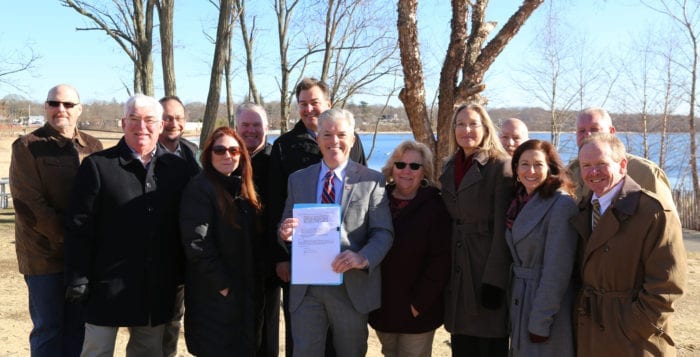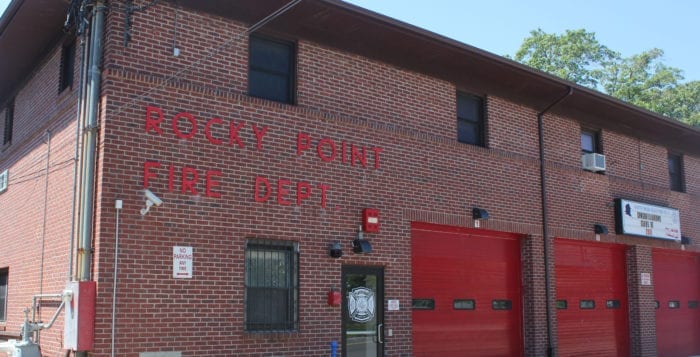Repairing old cesspools is now a thing of the past in Suffolk County.
As part of an ongoing effort to improve water quality on Long Island, Suffolk County Executive Steve Bellone (D) signed into law a ban on installing new cesspools, ending the practice of grandfathering inadequate
sanitary system fixes with the now-primitive technology.
“It marks another historic step forward in our ongoing effort to reverse decades of nitrogen pollution that has degraded water quality in our lakes, bays and harbors, and it is a step that is long overdue,” Bellone said. “It is fairly unusual for the local governments, environmental groups and the region’s largest builders group to agree on the importance of tightening up outdated regulations to protect water quality, but that is exactly what happened in this instance. This inclusive, collaborative approach is making a huge difference in our efforts to reduce decades of nitrogen pollution.”
Cesspools have been identified as primary sources of nitrogen pollution that have degraded water quality throughout Suffolk County, contributing to harmful algae blooms, beach closures and fish kills. The use of cesspools in new construction has been banned in the county since 1973, when a requirement for the addition of a septic tank was added, but the county sanitary code did not require that homeowners add a septic tank when replacing an existing cesspool, making it legal to install a new cesspool to replace an existing one. By now closing this loophole, it will advance the water quality efforts undertaken by the county and set the stage for the evolution away from the use of nonperforming cesspools and septic systems to the use of new, state-of-the-art technologies that reduce nitrogen in residential wastewater by up to 70 percent, according to Bellone.
“With this action, I would like to say that we, as a county, have adopted the policies necessary to adequately address our region’s nitrogen pollution problems, but in reality, this gets us closer to where we should have been in the decades following 1973,” said county Legislator Kara Hahn (D-Setauket), a co-sponsor of the Article 6 revisions and chairwoman of the Suffolk County Legislature’s Environment, Planning and Agriculture Committee. “I look forward to continuing the process of finally bringing Suffolk County’s sanitary code into the 21st century.”
In addition to banning the installation of new cesspools, the law approved by the Suffolk County Legislature Dec. 5 requires the wastewater industry to provide data regarding system replacement and pumping activities to the Department of Health Services beginning July 1, 2018. It also mandates permits for replacement of existing systems effective July 1, 2019, and requires business properties with grandfathered nonconforming wastewater flows to install nitrogen-reducing advanced systems if making significant changes to the use of the property.
Adrienne Esposito, executive director of Citizens Campaign for the Environment, joined forces with other environmental group leaders in thanking the county for what was a necessary step in eliminating nitrogen from groundwater.
“We can no longer allow inadequately treated sewage to mix with our sole source of drinking water,” she said. “Modernizing our health codes is a commonsense action that is critically needed for water protection.”
Richard Amper, executive director of the Long Island Pine Barrens Society, said he was overjoyed by the “huge step,” ending pollution by what he called Suffolk’s No. 1 threat to clean water.
“Now, we’re not just complaining,” he said. “We’re doing something about it.”
For the past three years, Suffolk’s Legislature has instituted a pilot program to test the new technologies, using a lottery system to select homeowners willing to have a donated system installed to demonstrate system performance. Under the pilot program, a total of 14 different technologies have been installed at 39 homes throughout the county. Four have been provisionally approved for use after demonstrating six months of acceptable operating data. As part of continued efforts, a voluntary Septic Improvement Program, the first of its kind in the state, was launched in July 2017 to provide grants and low-interest financing to make the replacement of cesspools and septic systems with new innovative/alternative technologies affordable for homeowners who choose to upgrade their systems. Over the first five months, nearly 850 homeowners have registered for the program, 228 have completed applications and 160 have been awarded grants and are moving toward installation of the new systems.
Suffolk County was the first in the state to apply for funding from New York State’s newly created $75 million Septic System Replacement Fund and will use the funding to expand its efforts to see the new technologies installed throughout the county.
The changes are the first in what is expected to be a series of updates to the county sanitary code over the next several years as county officials consider whether to put in place policies that require new nitrogen-
reducing systems in new construction projects, require installation of the new systems when a cesspool or septic system fails and needs to be replaced, or upon sale of a property. For now, all parties involved are on the same page moving forward, including both a working group comprised of county legislators, town planners and engineers with members of environmental organizations, as well as the Long Island Builders Institute.
“There is more work to do,” said Kevin McDonald, conservation finance and policy director for The Nature Conservancy on Long Island. “But passage of this bill means less nitrogen pollution in our water, and more resilient, healthy bays and people for generations to come.”






